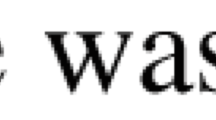Abstract
There are two interpretations of what it means for a singular term to be referentially direct, one truth-conditional and the other cognitive. It has been argued that on the former interpretation, both proper names and indexicals refer directly, whereas on the latter only proper names are directly referential. However, these interpretations in fact apply to the same singular terms. This paper argues that, if conceived in purely normative terms, the linguistic meaning of indexicals can no longer be held to make these terms referentially indirect under the second interpretation. This result is then generalized to proper names, by ascribing them a normative meaning as well.
Similar content being viewed by others
REFERENCES
Almog, J.: 1984, 'Semantic Anthropology', Midwest Studies in Philosophy 9, pp. 479–489.
Austin, J.L.: 1976, How to Do Things with Words, Oxford University Press, Oxford.
Boghossian, P.A.: 1994, 'The Transparency of Mental Content', Philosophical Perspectives 8, pp. 33–50.
Donnellan, K.S.: 1966, 'Reference and Definite Descriptions', The Philosophical Review 75, pp. 281–304.
Dummett, M.: 1981, Frege: Philosophy of Language, Duckworth, London.
Evans, G.: 1973, 'The Causal Theory of Names', Proceedings of the Aristotelian Society 47, pp. 187–208.
Kaplan, D.: 1979, 'Dthat', in French, P.A. et al. (eds.), Contemporary Perspectives in the Philosophy of Language, University of Minneapolis Press, Minneapolis, pp. 383–400.
Kaplan, D.: 1989a, 'Demonstratives', in Almog, J. et al. (eds.), Themes from Kaplan, Oxford University Press, Oxford, pp. 481–563.
Kaplan, D.: 1989b, 'Afterthoughts', in Themes from Kaplan cit., pp. 565–614.
Kaplan, D.: 1990, 'Words', Proceedings of the Aristotelian Society 64, pp. 93–119.
Kripke, S.: 1980, Naming and Necessity, Blackwell, Oxford.
Leonardi, P.: 1990, 'On Hector-Neri Castañeda's Proper Name', in Jacobi, K. and Pape, H. (eds.), Thinking and the Structure of the World, Walter de Gruyter, Berlin, pp. 230–243.
Marconi, D.: 2002, 'The Normative Element in Semantic Theory', in Hinzen, W. and Rott, H., (eds.), Belief and Meaning, Essays at the Interface. Philosophical Analysis 3, German Library of Sciences, Hänsel-Hohenhausen, Frankfurt a.M.: pp. 215–228.
Martí, G.: 1995, 'The Essence of Genuine Reference', Journal of Philosophical Logic 24, pp. 275–289.
Martí, G.: 2001, 'Reassessing the Semantic Significance of the Referential/Attributive Distinction', paper presented at the conference David Kaplan: From This to That and From Ouch to Oops, University of S. Marino, 10-13 May, 2001.
Martí, G.: 2003, 'The Question of Rigidity in New Theories of Reference', Noûs 37, pp. 161–179.
McDowell, J.: 1998, 'The Woodbridge Lectures 1997: Having the World in View: Sellars, Kant and Intentionality', The Journal of Philosophy 95, pp. 431–492.
McGinn, C.: 1989, Mental Content, Blackwell: Oxford.
Napoli, E.: 1995, '(Direct) Reference', Journal of Philosophical Logic 24, pp. 321–339.
Newen, A.: 1998, 'Reference and Reference Determination: The Interpretational Theory', in Voltolini, A. (ed.), Reference, Thought, and Context(Lingua e stile 33 1998), Il Mulino: Bologna, pp. 515–529.
Pelczar, M. and Rainsbury, J.: 1998, 'The Indexical Character of Names', Synthese 114, pp. 293–317.
Perry, J.: 1997, 'Indexicals and Demonstratives', in Hale, B. and Wright, C. (eds.), A Companion to the Philosophy of Language, Blackwell, Oxford, pp. 586–612.
Perry, J.: 2001, Reference and Reflexivity, CSLI Publications, Stanford.
Recanati, F.: 1993, Direct Reference, Blackwell, Oxford.
Recanati, F.: 1994, 'Processing Models for Non-literal Discourse', in Casati, R. et al. (eds.), Philosophy and the Cognitive Sciences, Hoölder-Pichler-Tempsky, Vienna, pp. 343–356.
Reimer, M.: 1991, 'Demonstratives, Demonstrations, and Demonstrata', Philosophical Studies 63, 187–202.
Strawson, P.: 1950, 'On Referring', Mind 59, 320–344.
Voltolini, A.: 1995, 'Indexinames', in Hill, J. and Kot'àtko, P. (eds.), Karlovy Vary Studies in Reference and Meaning, Filosofia-Φιϰoσoϕια Publications, Prague, pp. 258–285.
Yagisawa, T.: 1998, 'Naming and Its Place in Reference', in Reference, Thought, and Context cit., pp. 445–458.
Wettstein, H.: 1984, 'How to Bridge the Gap Between Meaning and Reference', Synthese 58, pp. 63–84.
Wettstein, H.: 1986, 'Has Semantics Rested on a Mistake?', The Journal of Philosophy 83, pp. 185–209.
Wittgenstein, L.: 1952, Philosophical Investigations, Blackwell, Oxford.
Author information
Authors and Affiliations
Rights and permissions
About this article
Cite this article
Voltolini, A. Can there be a Uniform Application of Direct Reference?. Erkenntnis 61, 75–98 (2004). https://doi.org/10.1023/B:ERKE.0000037521.46052.17
Issue Date:
DOI: https://doi.org/10.1023/B:ERKE.0000037521.46052.17




